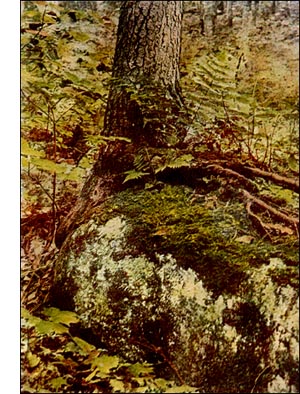Common White Moss
 Common White Moss, Leucobryum vulgare, Hampe.
Common White Moss, Leucobryum vulgare, Hampe.Habit and habitat.-Conspicuous in white cushions about the roots of trees in woods and on the borders of swamps. It is not uncommon to find on the terminal leaves of female plants minute tufts of root-like hairs developing a cluster of young plants, which may fall to the ground and form a new colony.
Name.-From the Latin, vulgaris, common.
Plant (gametophyte).-Whitish ; stems 2 to 8 inches high, two-forked with the primary branches of equal height and the secondary in clusters (fastigiate).
Leaves.-Half-clasping at the base, lance-shaped, and tubular from the middle upward ; vein occupying most of the leaf blade ; apex acute or obtuse with a short, sharp point.
Habit of flowering.-Male and female flowers on separate plants (dioicous). The male plants in distinct tufts, and more slender, with the flower-clusters terminal, in a rosette of six oval bracts.
Veil (calyptra).-Large, white.
Spore-case.-Oblong-egg-shaped, chestnut colour, black when old, slightly wrinkled lengthwise when dry. The base (collum) distinctly swollen on one side.
Pedicel (seta).-Dark-brown, twisted to the left when dry; 1/2 to 3/4 of an inch long.
Lid (operculum).-Conical, long-beaked, oblique.
Annulus. -None.
Teeth (peristome).-Sixteen, lance-shaped, red at the base, cleft to below the middle into two unequal forks.
Spores.-Mature in winter or early spring.
Distribution.-Common all over the world, except in Asia.